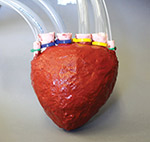Researchers at Cornell University have developed a material with the consistency of memory foam that could allow air or liquid to move through prosthetic devices; a hand is the first prosthesis under development. The lightweight and stretchable polymer (elastomer) foam can be formed and has connected pores that allow fluids to be pumped through it. The foam starts as a liquid that is poured into a mold to create a shape, and because of the pathways for fluids, when air or liquid is pumped through it, the material moves and can change its length by 300 percent, according to the Cornell Chronicle. Aside from prostheses, the material is being tested for artificial organs and soft robotics.

A soft foam water pump molded in the shape of a human heart. Photograph courtesy of Ben Mac Murray, Cornell University.
The porous channels are made by mixing salt with the elastomer while it’s in liquid form. Once the elastomer cures and hardens, the salt is removed. To seal a prosthesis or organ so air or fluid can be pumped through it without escaping, the researchers coat the outside with the same polymer but without the salt.
“We are currently pretty far along for making a prosthetic hand this way,” said Robert Shepherd, PhD, assistant professor of mechanical and aerospace engineering at Cornell, and senior author of the study. Benjamin Mac Murray, a graduate student in Shepherd’s lab, is the paper’s first author.
In the study, published online September 19 in the journal Advanced Materials, the researchers describe a pump they made with the material that was able to mimic the shape and function of a human heart. They used carbon fiber and silicone on the outside to fashion the structure that expands at different rates on the surface, such as making a spherical shape into an egg shape that holds its form when inflated.




